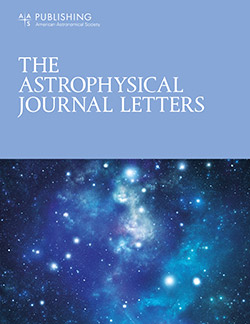模拟恒星Ca ii H和K发射变化:斑对s指数的贡献
IF 8.8
1区 物理与天体物理
Q1 ASTRONOMY & ASTROPHYSICS
引用次数: 0
摘要
S指数是测量Ca ii H和K线发射的指标,是广泛使用的恒星磁活动的代理。到目前为止,人们一直认为S指数主要受色球层中亮斑区域的影响。特别是,星黑子对S指数的影响一直被忽略。在这项研究中,我们重新审视了这一假设。为此,我们分析了瑞典1米太阳望远镜在Ca ii H光谱线上记录的太阳黑子的高分辨率观测结果,并确定了黑子与安静环境的对比。我们发现,在整个太阳黑子(包括超半影)上平均的Ca ii H线核心比在安静的环境中更亮,并且线核心的黑子对比度与斑对比度相当。这使我们能够初步估计点对S指数的影响。我们发现斑点增加了S指数。虽然这种增加对太阳来说相当小,但对于更活跃的恒星来说,它会变得更大。此外,我们还证明了黑子对S指数的贡献对S指数与黑子和光斑覆盖的星盘面积之间的关系有强烈的影响,并提出了新的关系。本文章由计算机程序翻译,如有差异,请以英文原文为准。
Modeling Stellar Ca ii H and K Emission Variations: Spot Contribution to the S-index
Abstract The S -index is a measure of emission in the Ca ii H and K lines and is a widely used proxy of stellar magnetic activity. It has been assumed until now that the S -index is mainly affected by bright plage regions in the chromosphere. In particular, the effect of starspots on the S -index has been neglected. In this study, we revisit this assumption. For this, we analyze high-resolution observations of sunspots recorded in the Ca ii H spectral line at the Swedish 1 m Solar Telescope and determine the contrast of spots with respect to the quiet surroundings. We find that the Ca ii H line core averaged over whole sunspots (including superpenumbrae) is brighter than in the quiet surroundings and that the spot contrast in the line core is comparable to the facular contrast. This allows us to get a first estimate of the influence of spots on the S -index. We show that spots increase the S -index. While this increase is quite small for the Sun, it becomes significantly larger for more active stars. Further, we show that the inclusion of the contribution of spots to the S -index strongly affects the relationship between the S -index and stellar disk area coverages by spots and faculae, and present the new relations.
求助全文
通过发布文献求助,成功后即可免费获取论文全文。
去求助
来源期刊

Astrophysical Journal Letters
ASTRONOMY & ASTROPHYSICS-
CiteScore
14.10
自引率
6.30%
发文量
513
审稿时长
2-3 weeks
期刊介绍:
The Astrophysical Journal Letters (ApJL) is widely regarded as the foremost journal for swiftly disseminating groundbreaking astronomical research. It focuses on concise reports that highlight pivotal advancements in the field of astrophysics. By prioritizing timeliness and the generation of immediate interest among researchers, ApJL showcases articles featuring novel discoveries and critical findings that have a profound effect on the scientific community. Moreover, ApJL ensures that published articles are comprehensive in their scope, presenting context that can be readily comprehensible to scientists who may not possess expertise in the specific disciplines covered.
 求助内容:
求助内容: 应助结果提醒方式:
应助结果提醒方式:


